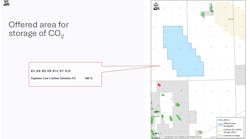HAZARDOUS WASTE DISPOSAL: Treatment process minimizes radioactivity disposal problem
The naturally radioactive materials that can accumulate in piping and other components offshore often present operators with a disposal problem. Many types of rock are naturally radioactive to some degree and drilling activities can produce cuttings and slag that retain a measurable amount of radiation.
Although such accumulations rarely create a health hazard for offshore workers, strict safety regulations demand the safe disposal of radioactive materials. Studsvik RadWaste operates processing and recycling facilities at its premises at Nyköping, Sweden, from where it is offering services to the nuclear industry. Based on their experiences from these activities, the company has moved into the oil and gas industry field by starting a research and development project regarding treatment of scales.
Because naturally occurring radioactive materials (NORM) held as scale in pipes are not regarded as arising from a natural process, North Sea regulations formulated under the Oslo/Paris convention prohibit their re-injection into the well. Although local regulations vary around the world, as do the radiation levels present in the regional geology, the only practical alternative to re-injection is to separate and recycle the contaminated materials.
This can typically result in less than 5% of the volume of the original consignment remaining measurably radioactive. Processed metal can be re-used, while the concentrated radioactive nucleides are in a condition suitable for cost effective and controlled disposal or storage.
Studsvik is now working on a new process for the treatment of scales. The solid and liquid phases are separated first, after which the active solids are separated from the inactive solid phase. This leads to a much smaller volume to be disposed of as radioactive waste, resulting in lower costs for the oil and gas industry.
Offshore requirements
The metals that are to be scrapped after the de-scaling but cannot be free- released directly, can be melted in a furnace like the one at Studsvik. During the carefully controlled melting operation samples are taken for each batch and these are analyzed for their radioactive content. When the latter is below the limit set for unconditional free release, the metal can be recycled to the steel industry. The radioactive scales recovered in the process will have been reduced to a stable form of non-metallic salt, which, because their volume is significantly smaller than the original material, will minimize the disposal or storage fee that the oil company is faced with.
Studsvik has been involved with handling and processing of low level radioactive waste for safe disposal since 1976. It began with a service to hospitals, research establishments, and the nuclear power industry for the incineration of contaminated materials - a process requiring careful handling techniques and advanced filtration systems.
In 1987, Studsvik extended its services to include the cutting-up and melting of low level radioactive metals. So far, the company has offered its services mainly to the nuclear industry, but as part of the day-to-day activities, it has been more and more obvious that there is a need for similar services to the oil and gas industry.
Leif Andersson, Managing Director of Studsvik RadWaste, explained the situation affecting oil and gas producers. "The problem is due to NORM, which originates from the natural decay of uranium (U-238) and thorium (Th-232). The dominating nucleides are, therefore, Ra-226, Pb-210, Ra-228, and Th-228," he said. "When oil and gas is extracted, radioactive isotopes are mixed with other substances and deposited as a layer on the inner surfaces of pipes, valves, and other components. This radioactive deposit is generally referred to as LSA (low specific activity) scales.
"When components and pipes are descaled for maintenance or recycling purposes, mainly by high pressure water jetting, the produced LSA scales must be disposed-of in accordance with local legislation."
Locally permissible radiation limits vary widely and can dramatically affect the offshore operator's costs. Norway, for example, allows up to 10.0 bequerels of radiation per gram of material to be released back into the environment. However, in the UK sector, the limit is set at 0.4 bequerels per gram, and this can affect the costs faced by the offshore operator due to his obligation to ensure the safe disposal of radioactive materials that have been produced by his activities.
Safety and containment are important priorities at the Studsvik plant which undergoes effective process control and treatment of released gases to ensure that the local environment is unaffected by processing activities. Releases of uncontaminated dust into the atmosphere from the plant have been shown to be less than 4% of the permissible limits set by the Swedish authorities. Radioactive releases are even smaller, being barely 1% of the safe limit set by the authorities. This ensures that the entire operation presents a safe and cost effective solution to the offshore operator's problem.
For more information, contact Leif Andersson, Studsvik RadWaste. Tel: +46 155 22 15 00 Fax: +46 155 26 30 47, Email: [email protected]


